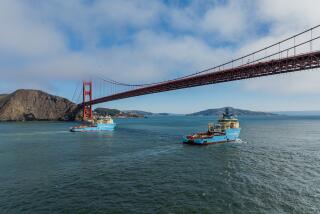Exxon Estimates Alaska Oil Spill Cleanup Will Cost $1.3 Billion
- Share via
Exxon Corp. said Monday that cleaning up the massive oil spill in Alaska could cost about $1.3 billion, making it one of the most expensive environmental disasters in history and clearly the most costly oil spill mop-up.
The March 24 spill by the Exxon Valdez is expected to cost the company itself $880 million, and the company’s insurers are expected to pick up the tab for an additional $400 million in cleanup expenses.
The salvage effort would rival the $973-million cleanup of the damaged nuclear reactor at Three Mile Island in 1979 and dwarf the $100-million to $200-million tab for the world’s worst spill from a tanker, the Amoco Cadiz, which dumped 68 million gallons of oil off the coast of France in 1978.
Exxon officials did not break down the costs of scrubbing more than 700 miles of oil-fouled beaches in Prince William Sound and the Gulf of Alaska. But, said Michael Nussman, a staff member on a Senate subcommittee looking into the spill: “The majority of payments will be between Exxon and Joe Alaska who’s out there wiping rocks.”
In its second-quarter earnings report, Exxon said it has set aside $880 million to cover expenses and uncontested claims related to the spill of about 11 million gallons of oil. In addition, the company expects to file $400 million in spill-related claims against its pollution insurance.
In calculating costs of the spill, Exxon did not include any liability that could result from 143 pending lawsuits against the company--which Exxon said “cannot reasonably be assessed at this time.”
Setting aside $850 million in the second quarter for cleanup costs--on top of a $30-million provision in the first quarter--caused Exxon’s profits to plunge more than 86% to $160 million on revenue of $23.6 billion. That compared to net income of $1.2 billion on revenue of $21.6 billion in the like quarter a year earlier.
“Cleanup of the Alaskan oil spill was Exxon’s top priority in the quarter,” Exxon Chairman Lawrence G. Rawl said in a statement. “The magnitude of the required effort is huge and therefore costly.”
In testimony before a Senate subcommittee last week, Exxon USA President William Stevens, said the company had already spent $600 million on the cleanup.
That sum “would far surpass the amount of money spent on any oil spill cleanup anywhere in the world,” said Richard Golob, publisher of the authoritative Golob’s Oil Pollution Bulletin in Cambridge, Mass.
Among the cleanup’s costs:
- An army of about 10,000 workers, 1,000 ships and 70 aircraft. VECO Inc., the main contractor with roughly half the workers, had a payroll of more than $1 million per day, said Exxon spokesman Henry Beathard in Valdez.
- Reimbursements, including $14.5 million already paid to the state of Alaska, and two-thirds of a reported $46 million paid by the Coast Guard and the federal government. More than a dozen municipalities and Native American groups have received payments, including $480,000 to expand recreational vehicle and trailer grounds in Valdez overcrowded by cleanup crews.
- Claims by fishermen, cannery workers, tourist businesses and other private individuals hurt by the disaster. More than $40 million has already been paid, Beathard said.
- About $25 million to fix the damaged Valdez tanker itself.
- Environmental damage. The Department of Interior is reassessing the value of such damage now that a federal court has thrown out its previous methods, which were based in part on the market value of individual animals; the amount will almost certainly increase. Exxon is preparing its own valuation, Beathard said.
Alaska has estimated that 28,000 birds and 800 sea otters have been discovered dead, said David Ramseur, a spokesman for Alaska Gov. Steve Cowper.
Golob attributed the high cleanup cost to the spill’s location. “This incident involves extensive shoreline cleanup, and they tend to be very labor intensive and very long-lasting,” he said. “It’s also in a remote area, which makes logistics much more difficult.”
Despite the high price tag, analysts doubted that the costs would cause severe financial damage to Exxon.
“It’s a big number, but it won’t sink the firm,” said Rosario S. Ilacqua, an oil industry analyst with Nikko Securities in New York.
On Monday, Exxon’s stock closed down $1.625 a share at $45.125 in trading on the New York Stock Exchange.
“Financially, they’re extremely strong,” said George Friesen, an industry analyst with Dean Witter Reynolds in New York. “It won’t cripple the company.”
Behind Schedule
Before the provision for cleanup costs, net income for the quarter was $1 billion. Earnings were down because of lower exploration production income, lost production from damaged North Sea oil facilities, higher capital spending and lower margins for refined products.
Estimates vary as to the progress of the cleanup, but most close observers contend it is behind schedule. The Coast Guard said 191 miles of beaches had been finished by July 20; another 286 miles were still being treated. With less than two months to go before a Sept. 15 deadline, it seems unlikely that Exxon will finish the cleanup as originally planned.
A controversy over the cleanup erupted Monday when reports surfaced of an internal Exxon memo stating the company’s intention to pull out of Alaska for the winter on that date. The memo was prepared by Exxon Valdez Operations Manager Otto R. Harrison to inform employees of congressional testimony last Friday by Exxon USA President Stevens, the company said.
May Not Resume
“It’s not open to negotiation,” Beathard said. “We said we were glad to discuss it with any of the agencies (involved), but we do not plan to ask any of them for permission when we think it is time to get our people out for reasons of safety.” He added that Exxon would return in the spring to assess damage along the shorelines, but not necessarily to resume cleanup work.
State officials strongly opposed Exxon’s plans. “We believe they should stay throughout the winter, at least on a limited basis, and they should have a strike force available in case the oil approaches sensitive areas, such as fish hatcheries or spawning areas for marine mammals,” Ramseur said from the Alaska governor’s office.
More to Read
Sign up for Essential California
The most important California stories and recommendations in your inbox every morning.
You may occasionally receive promotional content from the Los Angeles Times.













